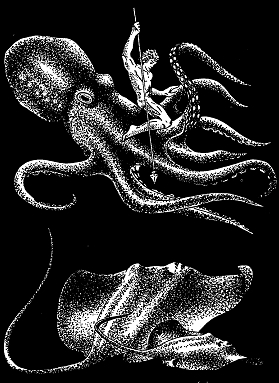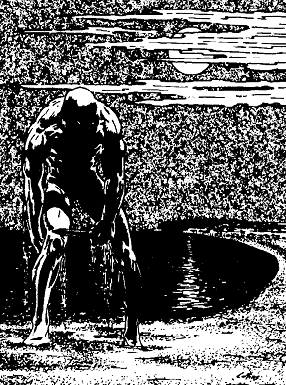

I’d like to be under the sea,
in an octopus’s garden, in the shade.
-The Beatles
| - | - | - | - | - |
| Dragon | - | - | - | Dragon 48 |
In D&D® Supplement II, Blackmoor, and in the AD&D™ Dungeon
Masters Guide, much information is given on undersea
adventure. This article will address some of the more often
overlooked aspects of an undersea fantasy sub-campaign.
The first and most obvious problem is simply stated: Mammals do not
breathe water. The game offers many ways around
this problem, such as potions of water breathing, Magic-users’
spells, and other magic items that allow underwater activity. The
reverse problem is less troublesome: Mermen may leave the
water for brief periods, and the loathsome sahuagin (known as
“sags” to their many enemies) actually storm ashore on dark
nights to sack villages. One would assume that some hardier
individuals of each of those races might brave heat enough to
work iron, in coastal smithies or on small islands. (Perhaps with
an apprentice to douse the scaly smith with buckets of cold sea
water. There are, however, objections to sea folk using worked
iron at all, which will be discussed later in this article.) The
general rule of respiration seems to be that intelligent seacreatures
can breathe air for a little while, but one good lungful
of water will do in a human.
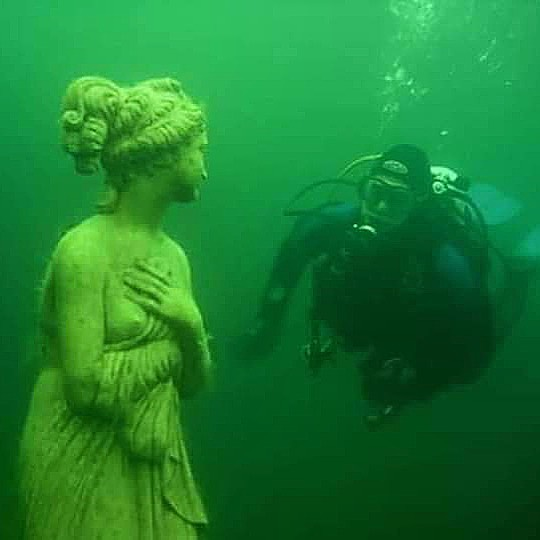
This leads one to wonder why there are any coastal airbreathers’ villages
at all. If the sea-folk and their monstrous pets
can wade in on a dark night and butcher a hamlet, and if the
land-folk cannot retaliate in kind, why wouldn’t the humans
eventually give up, go inland, and raise beets?
The answer, of course, is the land-folks’ superior technology.
While there just might be a few iron-working mermen, the overall tech
level of the sea-folk is probably equivalent to man’s late
Neolithic period (at the end of the Stone Age). They may have
crossbows, tridents, nets, shields, superior night vision, and
probably tactical surprise, but they don’t have fire, siege artillery,
and horses. Above all, sea-folk on land are hampered by
the painfully dry air, by gravity, and by restricted terrain. They
must also overcome ditches, walls, and other earthworks, all of
which are alien to their three-dimensional way of thinking. If a
merman can feel claustrophobia, an attack on a human village
must surely provoke it.
The mermen would succeed anyway if the village was small,
so presumably coastal villages are large and well fortified unless
a distinct truce or alliance exists between land dwellers and
sea-folk.
The advantages of such alliances are obvious (the mermen
run the fishing industry while the airbreathers provide trade
items, material and ideas—books cannot be preserved underwater; besides,
most mermen are illiterate.) One must assume
double villages exist in many areas — communities side by side,
where mermen and landsmen cooperate for mutual profit.
The earlier estimate of merman as no farther advanced than
the late Neolithic needs amplification. I assume that flint for
tools is available undersea (in sea cliffs, crags, and caves).
Bone, whale bone, sinews and skins are plentiful. Would the
sea-folk trade pearls or amber for steel knives? Would they even,
as postulated earlier, forge their own?
Probably not. Aside from the fact that steel rusts rapidly in the
ion-charged salt water, metal utensils are not as good for the
merman’s purpose as are flint ones. It has been demonstrated
repeatedly that a man can skin a buffalo quite a bit faster with a
good flint knife than with a steel one. The same would apply to a
shark, walrus, or water buffalo.
The flint knives of the human Neolithic are unparalleled for
edge, durability, efficiency, and beauty. Modern experimenters
must practice for years to produce a good, neo-Neolithic leafpoint.
Can the mermen be expected to do as well? No; they can
be expected to do better. Water has a strange effect upon brittle
solids: when immersed, such solids resist shattering. It is possible
to cut a piece of glass underwater with shears, a procedure
impossible in air. The piles of ruined spear-points that archaeologists
have found throughout Europe would be unknown
to the mermen. Their spear-points, arrowheads, and knives
would have a symmetry, beauty, and functional delicacy not
achieved by human flint-workers.
Mermen’s weapons include spears, tridents, the “speciallymade crossbow”
mentioned in Blackmoor and the DMG, and
some specialized weapons suited to underwater work. A net,
especially if set with dozens of small hooks, presents a formidably
entangling defensive weapon. Noisemakers can be used
against the sahuagin, damaging their supersensitive underwater hearing.
(Indeed, the hearing of all creatures underwater is
less acute, because sound travels through water more easily
than through air; mermen on land would seem rather deaf.)
Throwing daggers are replaced by streamlined darts, the caltrop by the
net, and the axe by a fan-shaped implement with the
blade thrust forward on a pole. Pole-arms in general are preferred
to swung weapons because of the water’s resistance
against something swung through it. Grappling hooks are
common, for slowing as well as wounding targets. Sacs of ink
can be used for smoke screens, and bladders of acid or poison
can be released down-current to injure the enemy.
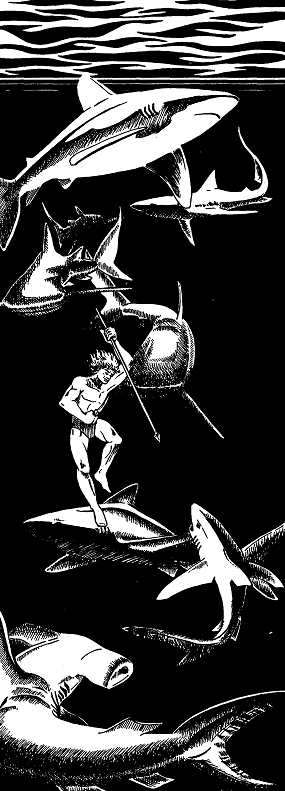
Transport is said to be by the ubiquitous sea-horse, or hippocampus.
Aside from its poetic ludicrousness, the scheme is
unworkable, silly, and should be laughed at by anyone studying
the situation carefully. Carrying burdens, however, by means of
pack-dolphins, makes more sense, as does the use of dolphins
as towing engines to help speed a journey.
The D&D books suggest that mermen herd fish, and keep
these herds in pens. This strikes me as implausible. (Alas, Gary
Gygax is correct: I can easily swallow the “whale” of mermen,
underwater cities, and sunken civilizations, but must choke
upon the “minnow” of submarine agriculture. “Realism” in these
terms is meaningless... Where was I? Oh, yes...implausible).
Since “big fish eat little fish, and bigger fish eat them,” keeping
a
herd of groupers involves catching ten times their weight in
angelfish daily. It’s a heck of a lot easier to just catch the groupers
in the first place. This may be one of the reasons the American Indians
hunted buffalo rather than domesticating them.
Feeding those “thunder cattle” would have been prohibitively
difficult. When one adds the problems of taming them, calving
them, leading them to water, etc., it makes a lot more sense to
battle them than to breed them.
The mermen must fight sharks, sahuagin, giant crabs, and
other nasties constantly. In combat, assuming their backs are to
the sea floor, they are still vulnerable from a full hostile hemisphere.
If they are caught in mid-sea, they can be attacked from
any angle (although I believe that if the floor is unavailable,
they’d hug the surface). With the heightened mobility that the
ocean provides, all battles become encirclements of a smaller
force by a larger one. If the smaller force cannot penetrate a
weak spot and break through, there can be no retreat. Even a
larger and stronger force, if individually slower, is in deep trouble.
The immediate problem becomes: how do we simulate such a
combat? The tactical game maps of SPl’s Battlefleet Mars and
Vector Three are tempting, but not totally suitable. The best
solution I’ve yet found, and one that space-wargame designers
have long used, is to put the battle on a two-dimensional map,
with abstract rules to simulate the feel of the “real” situation.
As an example, consider the case of 100 sharks facing 70
mermen. To keep the numbers reasonable, I’ll use five-being
counters; thus, 20 shark counters face 14 mermen counters. In
D&D terms, the sharks move 24” (let each inch equal 10 yards, to
match the standard D&D outdoor combat scale); the mermen
move 18”. Assume that the mermen are defending against the
ocean’s surface, while the sharks attack from below. Further
assume that 5 mermen or sharks can effectively fight and control a
100-square-yard area.
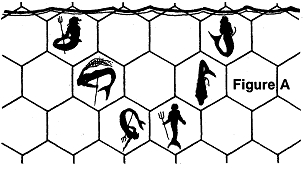
A slice through the side view of a standard hemispherical
defense would appear as in Figure A, where each hex is roughly
(Turn to page 84)
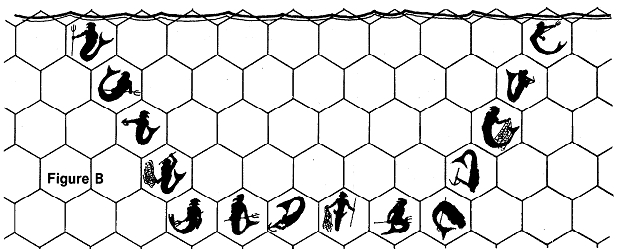
10 yards across. The illustration is only a cross-section; of the 14
counters in the defense, only six show, the rest being in front of
or behind the hex sheet, to fill out a three-dimensional hemisphere.
There are no “stacking” rules, and no “zone-of-control”
inhibitions. In this situation the sharks move 24 hexes per turn
and the mermen 18.
Figure B represents the two-dimensional analogue of the
same situation. Here, the linear frontage of each unit is a confused
mixture of area and length, and each hex measures
somewhere between 10 and 100 yards across. There is no movement “above”
or “below” the hex map; the situation is strictly
two-dimensional. Here, each shark counter moves 48 hexes per
turn (double the normal due to the distortion of the game-map);
each merman counter moves 36 hexes. These numbers arbitrarily may be
reduced to keep the combat on a normal-sized map, as
long as the sharks’ movement advantage is maintained in the
proper proportion.
Although distorted, Figure B nevertheless retains many of the
topological properties of Figure A. In both cases, all 14 mermen
counters face most of the 20 shark counters (not depicted), not
all of whom can attack at present. Until some of their comrades
die, there will be a few sharks left out of the battle for lack of
“elbow room.” The artificial restriction of the battle to a flat
board has virtually no effect upon the battle.
-
If the distortion is too appalling to the reader’s sense of naturalism,
some other method should be tried. This is the only
system I’ve yet found for such battles that worked well. In this
particular case, true three-dimensional simulation would be almost
as out of place as it would be in GDW’s Imperium.
Finally, two very minor points. First, why must the Giant Octopus always
be cast as the Bad Guy? Octopi are quite rational
beings, reacting coolly and logically to threats and to meal
opportunities. They are far less “evil” than wolves, tigers, or
jaguars; they are constitutionally incapable of any sort of angry
maliciousness.
Second, as anyone who has studied marine biology knows,
99% of all sea life is either on the continental shelves or floating
in the top three feet of the sea. The murky depths, although
sporting various peculiar high-pressure beasties, are relatively
barren. The mer-folk, swimming happily in the shallow, warm,
light blue water, think of these frigid, tenebrous depths much as
land-folk think of caves, pits, and mines: The dark unknown is
frightening — the home of devils and monsters. When crossing
deep places, mermen hug the surface of the water, just as humans cluster
about their torches when spelunking. At such times,
the superstitious fears of the two races are very nearly identical.
And just as humans nearly always bury their dead, sometimes
in caves and crypts, so do the mer-folk consign their dead to the
deeps. Wrapped in non-deteriorating shrouds, weighted with
great stones, the deceased are carried out to sea and dropped,
amid touching ceremonies, into the deepest part of the ocean.
Sea-folk most certainly do NOT eat their dead, such as has
been suggested in some works of literature — most lately a tale
entitled The Merman’s Children by Poul Anderson. It was
a nice
story, and in some parts quite factual, but in this respect it goes
just a little too far.
Best Fishes...
